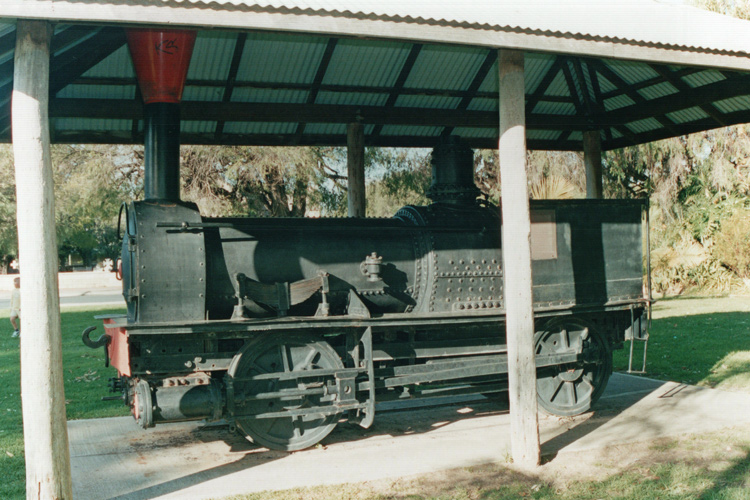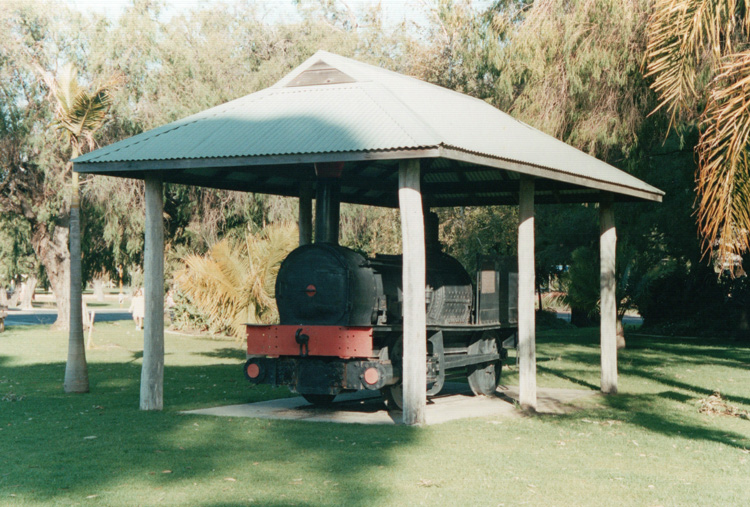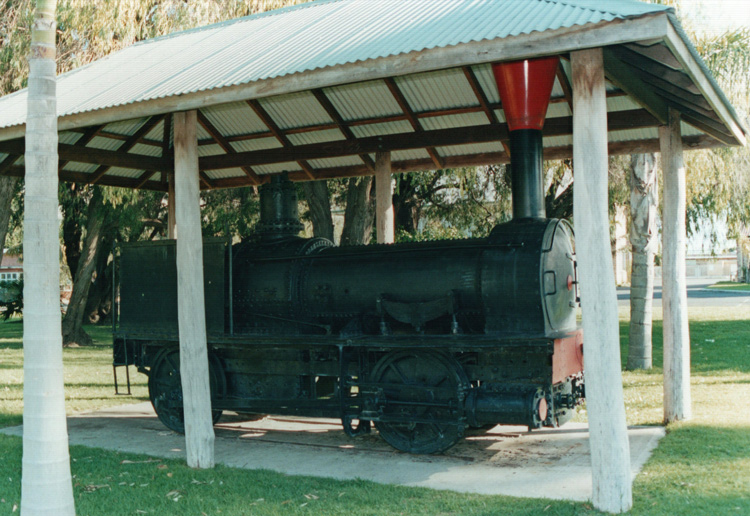|
|
Ballaarat The first steam locomotive to work in Western Australia |
|

‘Ballaarat’ displayed under a weather shelter at Victoria Square, Busselton on 12 May 2002.
One interesting feature to be seen is the running plate which extends over the buffer,
indicating where the former wooden
buffer beam would have been.
|
This
historic engine is the oldest surviving Australian-built steam locomotive and
also the first steam locomotive to work in Western Australia. ‘Ballaarat’ was
built at the Victoria Foundry and Ironworks, Ballarat, Victoria in 1871 and
takes its name from the original spelling of its city of manufacture. It was
ordered by the West Australian Timber Company for their 18km railway between
the port and mill at Lockeville, near Busselton, and timber concessions at
Yoganup. ‘Ballaarat’
was built as a 0-4-0WT however operating demands at Lockeville led to a
4-wheel tender quickly being added for additional fuel and water. The
footplate was shortened by 12 inches at this time. Early photos show that a
basic timber-framed roof of corrugated iron was also added over the cab.
‘Ballaarat’ was originally supplied with a cross-head driven pump for boiler
water feed; this early design required the locomotive to be moving whenever
the boiler needed topping up! Ballaarat appears rather squat and with a long
wheelbase for a 0-4-0 locomotive; this appearance is probably because the
rear axle is located behind the firebox. The valve gear (Gooch link motion)
was driven from the front axle. ‘Ballaarat’
is not really typical of locomotive design in the early 1870's but may have
been based on similar locomotives built by Fletcher Jennings & Co, such
as 0-4-0T ‘Baxter’ of 1877 which is preserved at the Bluebell Railway, Sussex. Ballaarat's
working career ended when the locomotive shed at Lockeville was destroyed by
fire around 1900. Ballaarat and tender, stored within, were severely damaged;
the tender's wooden frame was destroyed and Ballaarat's wooden buffer beams,
boiler lagging and cab were reduced to ashes. Ballaarat and tender
subsequently lay derelict for many years at the loco shed site, during which
time there was some consideration of having the locomotive restored by the
state Railway Department for display at the WA Museum. The tender found
re-use in 1922 and in 1925 the locomotive unit of Ballaarat was relocated to
the Midland Junction Workshops where it was assessed for restoration, however
the cost was considered excessive. Ballaarat appeared in the WA Centenary Parade
of 1929 on a horse float, but otherwise remained in storage at Midland
Workshops pending possible restoration and display. Concerned at the lack of
progress, Busselton Municipal Council arranged for Ballaarat to be returned
to Busselton in 1937 where it was placed on display in Victoria Square. Here
it remained for many years, cared for by the Busselton Municipal Council and
more recently protected from the elements by a weather roof. Given
its historical importance it is surprising that Ballaarat had not been
restored for display in a major Australian museum. Perhaps various museum
curators have assessed the locomotive as incomplete and unrepresentative and
therefore not worthy of display; conversely, a parallel could be made with
the somewhat incomplete and modified remains of Stephenson's Rocket - which
is a key exhibit in the Science Museum, Kensington, London. Philippa
Rogers has written a comprehensive and well-illustrated history of this
locomotive in ‘Ballaarat - Its story’ published in ‘Light Railways’ magazine
for April 2012. This excellent article is recommended for further information
about ‘Ballaarat’ and can be found in this free on-line sample copy of Light Railways No.224. UPDATE: ‘Ballaarat’
recently received conservation treatment and has been relocated to a new
indoor exhibition and function centre known as Railway House. This facility
is based on the original but relocated Busselton Railway Station (built 1884)
and opened to the public in March 2017. It is situated adjacent to the
Busselton foreshore and railway jetty and includes the Busselton Visitor
Centre. The locomotive is displayed within the eponymous ‘Ballaarat Room’ and photos show it is now housed in a
suitable climate-controlled environment, with interpretive signage and
certain fittings replaced such as wooden boiler lagging (although the front
wooden buffer has not been replaced). The various parties involved to this
significant and deserved improvement in Ballaarat’s state of affairs are to
be congratulated. |

Two further views of ‘Ballaarat’ displayed at Victoria
Square, Busselton on 12 May 2002.

References
|
a |
Higham, G. J., 'One Hundred Years of Railways
in Western Australia', Australian
Railway Historical Society W. A. Division, first printed 1971. |
|
b |
'Light
Railways - Australia's Magazine of Industrial & Narrow Gauge Railways', Number 224,
April 2012. Published by Light Railway Research Society of Australia Inc. |
|
c |
Casserley, H. C. 'Preserved
Locomotives' (Fifth Edition), published 1980 by Ian Allan
Ltd, Shepperton, Surrey, page 136. |
Page updated: 10 March 2018
|
Government Railways: |
|
|||||||||
|
Private & Industrial Railways: |
|